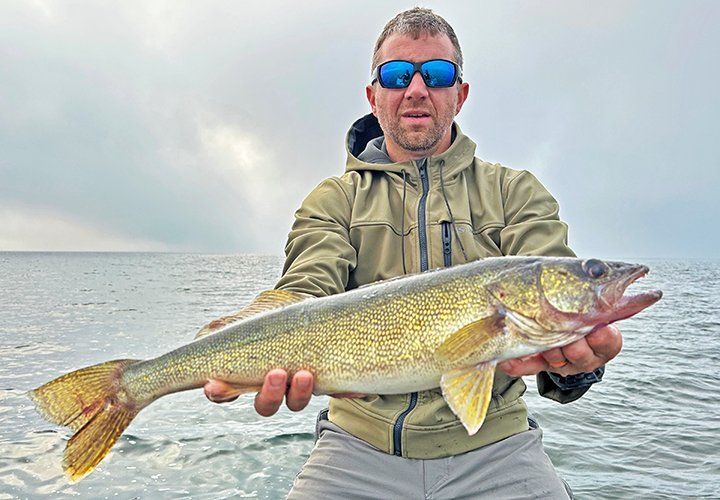Last week, stable, warm weather played into the hands of walleye anglers on Lake Winnie. As surface water temperatures approached their peak of almost 80 degrees last Sunday, there was a good algae bloom in the water. As the bloom became heavier, mid-lake structures produced good catches during the daytime and GREAT catches during the evening and early morning periods. The action reached its peak as a line of thunderstorms approached on Monday of this week.
Joe Nelson with fat Winnie Walleye
Post storm conditions caused a setback, and by Wednesday, the cool front had caused a drop in surface temperatures, the algae bloom was reduced, water clarity increased, and walleyes became finicky. Now, the walleye anglers who had good catches were the ones who fished early morning and late evening, daytime anglers settled for both fewer, and smaller fish.
Setbacks happen, but during this period of summer, seldom last very long. This is the time of summer when fish feed and grow the most. The forecast calls for warming temperatures, and relatively stable conditions to return. As the weather pattern stabilizes, and water temperatures rise, we expect to see a rebound in feeding activity. So, lets talk about the fishing patterns that worked well for our guests before conditions changed.
Megan Kempf with nice Winnie Walleye
Leeches were trending as the “best” live bait choice for walleyes. Delivered by many folks using slip-floats to suspend the offering a foot or two above the bottom, walleyes ate them willingly. Anglers also reported catching good numbers of walleyes using leeches presented on ¼ to 3/8-ounce jig heads. Fished vertically and held still with a “dead-slow” action, the jig and leech combos produced good catches. Lindy Rigs, with plain hooks were less effective because they often fall to the bottom and gather clusters of zebra mussels. Anglers who prefer fishing with live bait rigs should add a floating jig head, or other float ahead of the hook to help suspend the leeches above bottom.
Night crawlers, injected with air using a worm blower and presented on Lindy Rigs produced some fish too, and shouldn’t be overlooked. Walleyes feeding preferences change periodically, and it would be no surprise if worms became more effective in the near future.
Trolling with spinners did not make a lot of news last week, but there were some anglers using them effectively. Trolling on the high edges of the largest, and shallowest mid- lake bars produced good results last weekend, and on Monday. Key water depths ranged from 13 to 15 feet of water, long lining the spinners using ¼ to 3/8 ounce bullet weights ahead of the spinners worked well. Tipping the spinners with minnows or leeches were the two preferred bait choices.
Panfish are active, and action-oriented anglers might be interested in these as an alternative to walleyes right now. Sunfish have moved deeper, into the edges of deep-lying cabbage patches. They feed primarily on insect larvae, so tend to remain in areas where the best hatches are occurring. You can locate them using spinners tipped with night crawlers, or small leeches. Once located, you can catch more fish using a slower, vertical presentation. Jig heads tipped with cut pieces of night crawler or small leeches are good.
If you prefer using slip-floats, try rigging a flasher rig to appeal to the bluegill’s sense of curiosity. The rig consists of a slip float, and a small egg sinker held in place on your line by a simple barrel swivel. Below the swivel, use a plain hook, several colored plastic beads and a small, flashy, spinner blade on a 12-inch drop line. Tip the hook with small, lively leeches or worms and fish the outer edges, and gaps in the vegetation.
Crappies have been hitting but finding them has been tricky. They have been much more active during the very early morning hours, and this is the best time to search for them. Trolling the largest patches of vegetation will work, but casting small jigs like beetle spins, twister tails and other swimming baits may be better right now. Move slowly, look for gaps or pockets and cast into them. Let the lures fall, then retrieve using a slow, swim-fall-swim-fall retrieve. Most strikes will occur as the lures fall, so be deliberate and allow the action of the bait to do the work.


